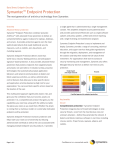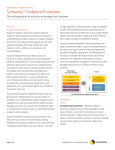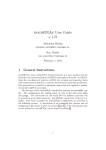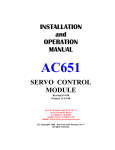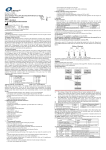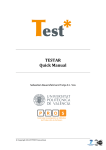Download User Manual - Bio
Transcript
User Manual Manual Biomedical Informatics Division, Rajendra Memorial Research Institute for Medical Sciences (I.C.M.R) Patna, India. Table of Content 1. Introduction to the Tool: a. About b. Requirement c. Installation 2. Using tool for operon prediction a. Input files b. Genetic Parameters c. Fitness function d. Start Prediction e. Output Visualization 3. Algorithm 4. Evaluation 5. Reference --- GAOPP: Genetic Algorithm for Operon Prediction in Prokaryotes 1. INTRODUCTION TO THE TOOL 1.1 What is GAOPP: GAOPP is standalone GUI tool for operon prediction. It uses unsupervised method Genetic Algorithm for identifying promoters in annotated prokaryotic species. It uses biological features like intergenic distance, Cluster of Gene Ontology and pathway involvement of each gene pair and clusters them in to operons. There are several computational methods are available for this purpose but none of them are GUI based. They need heavy data preparation, also. To meet these requirements GAOPP has been created. It has three different evaluating functions to evaluate the fitness of each putative operon structure, can be found in literatures. These functions use biological properties like intergenic distance, involvement in metabolic pathway, and functionality from Clusters of Gene ontology (COG) gene functional families. This need needs the protein table file found at National Centre for Biotechnology Information (NCBI) FTP ( ftp://ftp.ncbi.nih.gov/genomes/Bacteria/ ). For Pathway information KyotoEncyclopedia of Genes and Genome (KEGG) pathway database can be used. A track of experimental promoters in the target species can be used to predict promoters. Terminators can be predicted using TranTerm and the output file may be used to provide terminator coordinates in the genome. Windows version of the tool is currently available to download. Binaries for Linux platform will be released soon. 1.2 Installation on windows : 1. Download the zipped installation file and extract it. 2. To install the tool, simply double click on install.bat file. 3. It prompts you to enter installation directory. To accept default destination C:\GAOPP\ press y . Wait until the prompt closes. Double click on the shortcut icon at Desktop. GAOPP: Genetic Algorithm for Operon Prediction in Prokaryotes 4. To run it from source code, it requires PERL5.8 above and Tkx module. Active perl can be used instead. 5. To uninstall the program, simply go to the folder you installed and delete GAOPP directory. Remove the Desktop shortcut. GAOPP: Genetic Algorithm for Operon Prediction in Prokaryotes 1.3 System Requirement: 1. Operating system Windows 2000/XP/Vista/7 , Linux* (available soon) 2. To run from source code it requir requires es perl5.8 or above and Tkx installed. 3. To run larger genome sequences it may require higher configuration. configuration 4. Additional software like PDF reader and Post Script Viewer may be required. A B Fig -Different feel and look on Linux platform (A) and Windows Platform ((B) GAOPP: Genetic Algorithm for Operon Prediction in Prokaryotes .list pathway file .ptt file from NCBI TransTerm Out put Promoter Training set GAOPP: Genetic Algorithm for Operon Prediction in Prokaryotes 2. Working with GAOPP: 2.1 Input files: Download the required files like .ptt file and pathway file. Note down the KEGG organism code if you are planning to use pathway data, organism code has to be specified. Check that the .ppt file and pathway file are in the following format: For promoter prediction, a promoter training set need to be specified. A Perl script provided with the program may be used to extract the promoter and non promoter training sets. Simply run script specifying your input files and sequence file. The input files have same .ptt file format. To generate the positive input file, edit the .ptt file keeping only those genes which contains upstream promoter signals, and delete others. Similarly, for negative input file only those genes not having upstream promoter sequence. Run extractProm.pl : Perl extraxtProm.pl -pos <positive.ptt> -neg <negetive.ptt> -seq <nucl.fna> -out <output.txt> GAOPP: Genetic Algorithm for Operon Prediction in Prokaryotes Fig: Positive promoter input file Fig: Negative promoter inputfile GAOPP: Genetic Algorithm for Operon Prediction in Prokaryotes Your file is ready if all the sequences must have A(G)TG at the right side. In order to generate the terminator coordinates, we have provided a compiled transterm binary executable and expterm.dat file. This will run only on Linux platform (see transTerm usage file) Run the following command on Linux Terminal: transterm -p expterm.dat seq.fasta annotation.ptt > output.tt Remember to keep name of .ptt file and FASTA identifier in sequence file, exactly the same. And provide the sequence file earlier than .ptt file as the command line argument. The output file is written after ‘>’. To load the input files click on the respective buttons and click on browse to load the files. Providing incorrect files causes anonymous error or result may be ambiguous. GAOPP: Genetic Algorithm for Operon Prediction in Prokaryotes 1 3 2 4 5 2.2 Genetic Algorithm Parameters: Clicking on GA parameters button opens the parameter panel: 2.2.a Operator Probability: To implement genetic algorithm operators like Mutation and crossing over user need to set the probability. The probability indicates how often the operon has to be implemented. Generally a high cross over probability and low mutation probability combination gives optimized result. Use the sliders to adjust the probability. 2.2.b Selection: A selection procedure selects an individual solution to be act as a parent for crossing over and generate offspring for next generation. There are two options for selecting the parents i. Roulette Wheel Selection ii. Best Individual selection. GAOPP: Genetic Algorithm for Operon Prediction in Prokaryotes i. Roulette Wheel Selection: It selects an individual stochastically form the current generation by simulating rotation of a wheel with an objective to select the fittest individual. During the process individuals having higher fitness score has higher probability to get selected in comparison to less fit individuals. Fittest Individual has higher share ii. Weakest Individual has least share Best Individual: This method selects only the best individual from the generation. When user opts for this option, a higher mutation probability is advisable. 2.2.c Early Termination: On attaining the best plausible solution, all the individuals will look much alike and mutation and crossing over does not make any change to the population. Hence continuing the process is worthless. Click on this the check box if user wants to terminate the evolution process when specified number of individuals in the current generation has same score. GAOPP: Genetic Algorithm for Operon Prediction in Prokaryotes Initial Population Number must be higher than the number of individuals checked for early termination. 2.2. No. of Iterations: This option explicitly specifies how many generations are to be evolved to find the best possible solution. Set this option as per your convenience. Until and unless early termination is not defined the program will run until the specified generation. 2.3 Fitness Function: Click on Fitness Function Button to change the fitness function. Selecting a fitness function gives the literature reference used for calculating the score. Fuzzy Fitness Finder (Jacob et.al) function takes a long run about 10-12 hrs for whole genome. Remember to set early termination option when FFF is used. Rule based Fitness function is a heuristic one and can be used for quicker evaluation and doesn’t guarantee better prediction. 2.4 Result Visualization: Optimization process starts when start button is clicked. Like most standard GA software average fitness score in each generation plotted. This shows a uprising curve for successful optimization process. If the cure is not reliable (not uprising) user need to adjust the probabilities and run the program again. Click on export button to save the plot in postscript format (.ps) to view it later in any post script viewer like ghostviwer. Otherwise the progress.xls file can be open after the run and select the two columns and plot using XY sctter. GAOPP: Genetic Algorithm for Operon Prediction in Prokaryotes Average Fitness Score Score Optimization Average Fitness score 0 10 20 30 40 Generation Number GAOPP: Genetic Algorithm for Operon Prediction in Prokaryotes 50 Operon clusters along with their corresponding scores are displayed in the result panel when Result in Text Button is clicked. Result exported to hard disc. A Graphical viewer has been designed to represent individual operon clusters along with the promoter and terminator signals. The list of operons is displayed on the top. Selecting an cluster displays its total score at the bottom of list. Double clicking on a particular entry loads the entire operon map with terminator and promoter signals. Map in postscript format can be exported. A B Fig: Output panel: Result in Text form (A) and Result in Graphical (B). Graphical Result Shows visualizes regulatory signals. GAOPP: Genetic Algorithm for Operon Prediction in Prokaryotes 3. Algorithm: START .PTT FILE .LIST FILE+ TERMINATOR COORD+ PROMOTER TRAINING+ CREATE n INITIAL POPULATION USING RANDOM THRESHOLD DISTANCE TERMINATION True STOP False GENERATION GENERATION +1 CALCULATE FITNESS OF EACH OPERON CLUSTER fi α SCORE OF INDIVIDUAL f= ∑ -SINGLE POINT CROSS OVER -MUTATION CURRENT POPULATION POPULATION NEXT N.B: + marked files optional GAOPP: Genetic Algorithm for Operon Prediction in Prokaryotes α OPERON START, m OPERON END, n TOTAL SCORE ,k 0 False m != n True i m Di,i+1 INTERGENIC DISTANECE BETWN GENE i AND GENEi+1 D Di,i+1 +D j j+1 P++ IF GENEi AND GENEj BELONG TO SAME PATHWAY C++ IF BOTH GENEi AND GENEj HAVE SAME COG CLASS i i+1 True j<=n False True i<=n False D D/(n-m) , C C/ ( P / ( ) ) k COMBINE D, P, C USING SPECIFIED METHOD (BPSO, FFF, RULE_BASE) RETURN ‘k’ GAOPP: Genetic Algorithm for Operon Prediction in Prokaryotes j j+1 Evaluation: We used GAOPP for available test sets like Escherichia coli K-12 substr-MG1655and Bacillus subtilis. We created positive and negative gene pairs from available experimental data. The predicted operons were compared with these available test set. From these observations we constructed Receiver operating curve. ROC for Bacillus 1 True Positive Rate 0.8 0.6 RULEBASED_path BSPO_path 0.4 FUZZY_path 0.2 0 0 0.2 0.4 0.6 0.8 1 False Positive Rate GAOPP: Genetic Algorithm for Operon Prediction in Prokaryotes ROC for E.coli 1 0.9 True Positive Rate 0.8 0.7 0.6 0.5 BPSO_path 0.4 Rule_guided Fuzzy_guided 0.3 0.2 0.1 0 0 0.2 0.4 0.6 0.8 False Positive Rate GAOPP: Genetic Algorithm for Operon Prediction in Prokaryotes 1 Reference: GAOPP: Genetic Algorithm for Operon Prediction in Prokaryotes



















